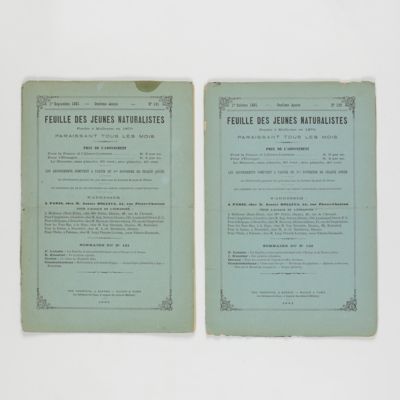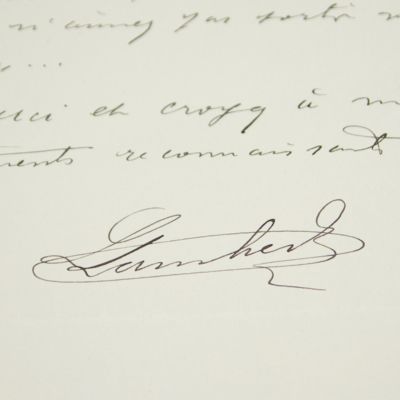'Without women, victory will tarry’ The start of women massively joining the workforce
[Women's Liberation] [André Citroën]
Application de la main-d'oeuvre féminine au travail des obus. [AND] Usines André Citroën. Vues photographiques des usines André Citroën de mars a ocobre 1915 [at] 143 quai de javel, Paris.
Published
1916
Item ID
77190
€6,800.00
Paris, Citroën, [1915]-1916. In two volumes. Oblong folio (31.5 x 43.7 cm). 71 original photographs (22.0 x 28.5-35.5 cm) mounted on grey cardboard with printed captions [60; 11]. Uniform full mottled calf. Boards with double gilt-rolled ornamental borders and gilt title.
A very rare set, both volumes dealing with the Parisian factory founded by André-Gustave Citroën (1878-1935), renowned for its technologically advanced cars, but also for its contributions to the French war industry during WWI, and in particular the contributions women made as factory workers in the mass production of artillery shells. The first volume is entirely devoted to this subject, showing the female munitions-workers at work. André Citroën played an essential part in French women's emancipation: once the women had left their traditional, singular role as homemakers, replacing the men who fought in the trenches, there was no looking back, and after the war their participation in the country's workforce became permanent. "World War I radically changed women's role in society, as they stepped into the boots of men gone to fight for their countries. In cities across Europe, women took on traditionally 'male' jobs - waiting on tables, delivering the mail, teaching in boys' schools or handling cash as bank clerks. 'Women rapidly became indispensable, not only in the nursing and welfare services but in offices and factories and agriculture, changing the whole balance of society in the process,' says historian Michael Howard. As soon as war broke out in 1914, France's prime minister Rene Viviani called on women to 'replace in the workplace those who are on the battlefield'. ... From 1915 onwards, Europe's industry - devoted to the war effort - relied massively on the female workforce, as did that of the United States from 1917. 'Without women, victory will tarry,' warned Britain's soon-to-be prime minister David Lloyd George in 1915. Some 400,000 women were toiling in France's war factories by 1918 - a quarter of the workforce - handling some 2,500 shells per exhausting 11-hour shifts" (AFP). The second volume records the building and operational start of the factory itself. It shows the evolution of the works, starting with a photo of the still-vacant lot (save for gardens and sheds), followed, chronologically, by views of all building developments, including one with the famous Eiffel Tower in the distance. Groundwork started in March 1915, and by the 28 September the largely female workforce had already become fully active. The final photo shows the official ceremonial opening of the factory, on 24 June 1916, revealing decorations given by General Gilinski on behalf of the Russian emperor. "As soon as war was declared in August 1914, André Citroën was mobilized as a lieutenant, then as captain in the 2nd Grenoble Artillery Regiment. On the eastern front he was able to witness France's lack of artillery and ammunition to counter the German forces. Following the death of his brother, Bernard, on the front, André Citroën was determined not only to do his duty, but also to repel the enemy as far as possible. In January 1915, he proposed to General Louis Baquet, director of artillery at the Ministry of War, which was sorely lacking in ammunition, to apply Fordism in a factory built in three months, and capable of producing 5,000 to 10,000 artillery shells of Type 75 per day.
read more
Thanks to his savings, those of his right-hand man Georges-Marie Haardt, and especially financing from a rich diamond dealer of Armenian origin, Atanik Eknayan, who had already saved his fragile Mors 12 car business, Citroën erected a huge ultramodern factory on 15 hectares of vacant land and vegetable gardens on the Quai de Javel. With some 13,000 workers, the factory produced 23 million shells at a rate of 10,000 per day, an unprecedented rate at the time. 'You have to produce quickly, well, and economically to put the products manufactured within the reach of the greatest possible number of consumers’, he said. The pace the factories imposed on workers was tiring, and as a result André Citroën was sometimes considered a despot. Nevertheless, he was one of the first manufacturers concerned about the well-being of his workers, and avoided imposing repetitive tasks. André Citroën's ammunition business quickly gained a reputation and became a model of organization, efficiency, and social responsibility. Major personalities, both civil and military, visited the factory. Between 1917 and 1918, the government also charged Citroën with reorganizing supplies for the armaments industry, the military postal services, and with the distribution of bread ration tickets in the Paris region. When the war was over, André Citroën decided to convert his factory on the Quai de Javel into a car manufacturing plan" (taken from French Wikipedia). Boards a bit rubbed; a skilful repair to one joint, one photograph with a brown spot in the top left corner; otherwise in an excellent state.
read less
![Application de la main-d'oeuvre féminine au travail des obus. [AND] Usines André Citroën. Vues photographiques des usines André Citroën de mars a ocobre 1915 [at] 143 quai de javel, Paris.](https://schierenberg.nl/media/cache/product_thumb/77190/77190_x.jpg)

![image for Original Art Deco design for wallpaper and/or textiles. ["Fruit"]](https://schierenberg.nl/media/cache/product_thumb/78429/78429_x.jpg)
![image for [Auvergne] Itinéraire de Clermont au Puy de Dome, ou description de cette montagne et de la Vallée de Royat et Fontanat; seconde edition. [AND] Two other papers on the geology of Auvergne, by A. C. P. F. Von Lasaulx, and by J. B. Bouillet, bound in.](https://schierenberg.nl/media/cache/product_thumb/66670/66670_x.jpg)


![image for Histoire naturelle des poissons de la France. Avec 220 figures dessinées d'après nature. I, II, III [AND] Histoire naturelle des poissons de la France. Supplément. Avec 7 figures dans le texte. [Complete].](https://schierenberg.nl/media/cache/product_thumb/16534/16534.jpg)
![image for D'une erreur de raisonnement très-fréquente dans les sciences du ressort de la philosophie naturelle qui concernent le concret, expliquée par les derniers écrits de M. E. Chevreul. [AND] Études des procédés de l'esprit humain dans la recherche de l'inconnu à l'aide de l'observation et de l'expérience, et du moyen de savoir s'il a trouvé l'erreur ou la verité, composé de trois mémoires. Premier mémoire. - La science devant la grammaire. Deuxième mémoire. - L'enseignement devant l'étude de la vision, avec deux planches. Troisième mémoire. - Explication de nombreux phénomènes qui sont une conséquence de la veillesse. [AND] Résumé d'une histoire de la matière depuis des philosophes grecs jusq'à Loivoisier inclusivement, avec quatorze planches, accompagnées de légendes.](https://schierenberg.nl/media/cache/product_thumb/71918/71918_x.jpg)


